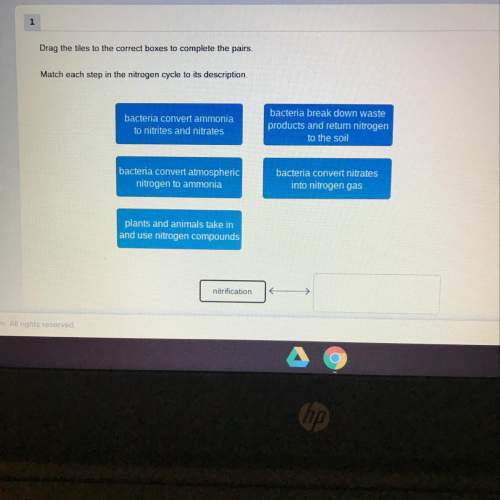
Biology, 27.03.2020 17:19 itssergioa
Meg goes swimming on a hot afternoon. When she comes out of the pool, her foot senses that the pavement is unbearably hot. Suppose Meg wants to apply the scientific method to discover reasons for the hot pavement. What is the next step she should take? A. analyze the data B. ask questions C. communicate the results D. make observations A. ask questions B. construct a hypothesis C. explain the results D. make observations

Answers: 1
Another question on Biology

Biology, 21.06.2019 14:00
Vegetation that grows along the floors of tropical and temperate forests is called undergrowth. how is the undergrowth of a tropical rain forest most likely to differ from the undergrowth of a temperate forest? a. a tropical rain forest's undergrowth most likely experiences periods of dormancy during colder weather. b. a tropical rain forest's undergrowth most likely experiences periods of dormancy during rainy weather. c. the undergrowth of a tropical rain forest most likely requires less sunlight. d. the undergrowth of a tropical rain forest most likely requires more sunlight.
Answers: 1

Biology, 21.06.2019 20:30
For your initial isolation of the bacterium, you simply needed to grow enough of it that you could identify some of its more general features. thus, you used a complex nutrient agar that would allow for the growth of almost any bacterial species. different bacterial species often have very specific requirements for life. this is a fact that you can utilize when you are trying to identify the bacterium to the species level. growth conditions that will permit the growth of one species but not another may allow you to select which one you would like to culture. you can utilize different selective/differential media that allow for the growth of only one type of bacteria (e.g., either gram positive or gram negative). culturing media such as phenylethyl alcohol or sodium chloride agar will be selective/differential for gram-positive bacteria. you may also want to show that it is different from other bacteria that may be present, so you could use a selective/differential agar. selective/differential media such as blood agar or phenol red sugar broths allow for the determination of whether a bacterial cell can grow and utilize specific ingredients included in the medium and turn the agar a distinct color. sheep's blood agar utilizes red blood cells to differentiate which bacterial species may have hemolytic properties.selective or differential? 1. an agar that uses a high salt concentration to limit the growth of one type of bacteria over another would be considered selective/differential. 2. if an agar contains a dye or ph indicator in the presence of a sugar, it is generally considered selective/differential for those bacteria that may ferment the sugar over those that cannot. 3. an agar that uses the dye in crystal violet agar suppresses the growth of gram-positive bacteria. this agar would be considered selective/differential. 4. the selective/differential aspect of macconkey agar allows for the determination of which bacteria are lactose fermenters and which are not. 5. a blood agar plate contains sheep red blood cells and allows for the determination of hemolytic capabilities for all bacteria that grow on the agar. this would make this type of agar selective/differential. 6. emb agar uses lactose and two dyes that allow it to be selective/differential between the blue-black colonies of e. coli and the pinkish colonies of all other enteric bacteria. 7. bile salts in macconkey agar allow for the agar to be selective/differential for the growth of enteric gram-negative bacteria over gram-positive bacteria. 8. an agar that allows for the distinction of bacteria based on metabolism would be considered selective/differential.
Answers: 1

Biology, 22.06.2019 05:00
(99 points) be serious! how do farts work? how do you fart without it stinking? serious answers only
Answers: 2

Biology, 22.06.2019 06:10
Aresearcher designed an investigation to test what effect eating different types of food would have on blood insulin levels. she selected 10 male subjects who were all 25 years of age and in good health. the experiment took place over 3 days. at 8: 00 a.m. on each day, the subjects ate a meal consisting of only 1 type of food. they had their blood insulin levels measured after consuming the meal. on day 1 they ate a high fat diet, on day 2 they ate a high protein diet, and on day 3 they ate a high sugar diel what is the independent variable in this experiment? a the age of the subjects b the blood insulin level c the type of food consumed d the time of day the meal was consumed
Answers: 2
You know the right answer?
Meg goes swimming on a hot afternoon. When she comes out of the pool, her foot senses that the pavem...
Questions

History, 21.12.2020 01:50

Computers and Technology, 21.12.2020 01:50

Computers and Technology, 21.12.2020 01:50

Mathematics, 21.12.2020 01:50


Social Studies, 21.12.2020 01:50

English, 21.12.2020 01:50


Social Studies, 21.12.2020 01:50



Chemistry, 21.12.2020 01:50



Mathematics, 21.12.2020 01:50

Biology, 21.12.2020 01:50







